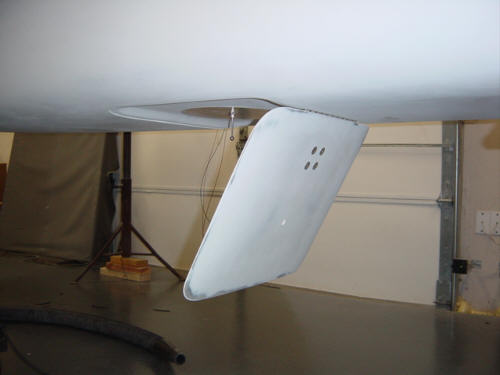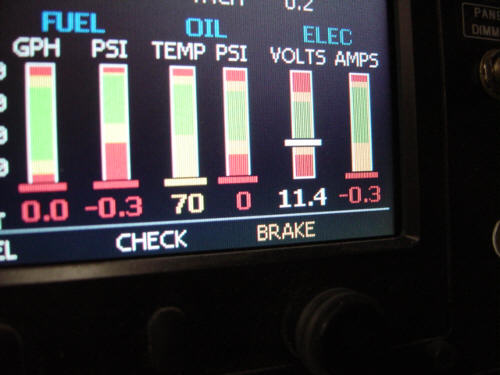

As far as I know, all canard aircraft have some sort of air brake built into their construction. They are very simple mechanisms and, like many things on this airframe, are used for multiple purposes. Nothing like having more than one reason to have something on an airplane...make the weight even easier to justify.
The first reason for the air brake is just that...to be a drag increasing device to help slow the airplane down for landing. That's right...something that ADDS drag to this airplane...but only when I want or need it! You see, because the airframe is SO efficient, simply pulling the power back like you would in a Cessna is not going to slow things down much - in fact there is nose drop at all. Extending the landing gear does a good job of creating drag, but the belly brake adds even more...and can be deployed in stages making it adjustable to the situation. Reason two - to block debris bound for the propeller that is kicked up by the nose wheel when on the ground. I've also added a bald nose wheel tire to help keep this to a minimum as well.
The original Long-EZ and many other canards use a mechanical lever activated belly brake, but with Berkut...we use an electric actuator. It's lighter, more controllable, and safer than the lever style. The actuator is mounted to the back of the pilot seat - see the "Innovations" section on the main page for more detail on the installation of the actuator itself. The secret to the installation is the use of a special "pinky" switch, relay and position switch.
The brake is controlled by an "ON-OFF-(ON)" switch that is mounted next to the throttle. The middle position is "OFF" and from there the pilot can flip the switch forward to fully retract the brake, or pull the switch back momentarily to "step deploy" the brake incrementally. Although the actuator simply free-wheels at the ends of its travel, a limit switch is depressed by a aluminum pad on the backside of the brake as the brake reaches full closure. The relay and limit switch then work together to turn off power to the actuator when the brake is fully retracted and to key the warning system when the brake is deployed and the throttle is advanced. Here is a closer look. Also note that the transponder antenna is mounted through the brake itself...pretty kewl, huh!
Belly Brake Movies (MPGs):
Belly brake "stepped" extension (600Kb)
Belly brake retraction (500Kb)

UPDATE 8-2-04: One of the many features of the ACS2002 engine monitor system is the ability to show the extension of flaps on the screen. I had the guys make a change in the code to allow the "Flaps" to be named "Brake" - that way, I can hook up a Ray Allen sensor and show the graduated extension of the belly brake. Kewl, huh. Hooking the sensor up was a bit of a pain since it was all done in the bottom angle of the back seat. I started by drilling a hole in the floor next to the hinge, then opened it up into an oval - like the actuator hole. Then, through a process of trial and error, I found a spot on the brake that describes 1" of travel up and down. I attached a small piece of hinge stock to the back of the brake and ran a small piece of hinge rod up into the fuselage. I attached the sensor to the other end of the rod and used double sided tape to attaches it to the seat back - in the proper position of course. I bent the rod in two different directions on the ends so that retaining clips are not necessary - the rod can not move left and right this way. After wiring it up, here is how it works - brake retracted, brake half-extended, and brake fully deployed.
 Back to the Proto-page
Back to the Proto-page